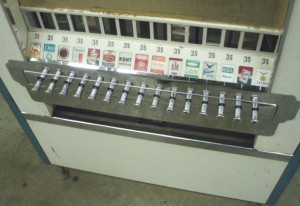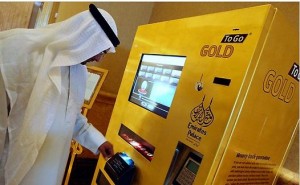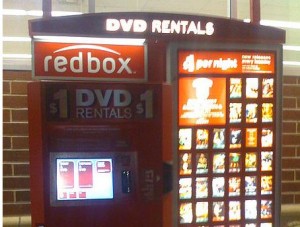My friend Bob from the Bloom Group suggested that I blog about the fact that companies that outsource work to countries like China and India are actually not getting such a great deal and that in a lot of cases those jobs should stay here at home.
I think he’s absolutely right about the first point, but I think the biggest threat to jobs is actually right here at home and it has nothing to do with the internet.
 It’s vending machines, or as Stephanie Rosenbloom says the new term is “automated retail store” in her article “The New Face of Vending Machines” the machines that used to sell cigarettes, candy, and really bad coffee are now selling just about everything. Even gold. Really.
It’s vending machines, or as Stephanie Rosenbloom says the new term is “automated retail store” in her article “The New Face of Vending Machines” the machines that used to sell cigarettes, candy, and really bad coffee are now selling just about everything. Even gold. Really.
As yawn-inspiring as vending machines may sound, the underlying rethinking that has gone on about what consumers want, how to manage trust and security, and how to collect more data about consumer behavior is stunning.
People want self-service (86% of us according to Rosenbloom’s article), merchants want higher revenue per square foot, and vending machines deliver a staggering 809%-2,930% more revenue per square foot.
That’s not a typo, eight-hundred and nine per cent is the low end of the range of revenue lift.
And of course with a lot less labor (that’s the outsourcing part), the profits jump even though there is some effort to keep stock levels up, though in the higher end machines from the likes of U*tique, they refer to it as “curating” the machine instead of stocking it, which reminds me of the first time I heard a luxury car called “pre-owned” instead of used, but at the same time there are some pretty big differences in the business models, so I will concede the use of a different word for managing inventory.
So the bummer is that this is likely to eat up more jobs and put some new pressure on retail stores, though it remains to be seen just how quickly this revolution will spread in the US – Japan already has one vending machine for every 23 people according to Rosenbloom’s article, which works out to over 5.5 million machines over there, by the way. That’s a lot of vending machines, I mean automated retail stores.
One of the things that I started to think about was the progression that got us from coins for candy to machines that take credit cards and scan our faces to see if we are wrinkly enough to buy cigarettes or condoms.
The ATM was a major milestone in 1967 when John Shepherd-Barron’s first machine was put in place for Barclay’s bank. The notion of outsourcing the bank teller to the customer was a pretty big move, and the fact that we still to this day just use a four digit code and a plastic card. Seems like lots of better ways to manage security.
Another big move was self-service check-out at stores like grocery stores. This was again a shifting of work, but they also figured out how to do it without having to trust the customer. The reason you have to weigh items when you use self-service checkout is so they can be sure you aren’t buying a ten pound lobster when you say you are buying a box of Cheerios cereal. That really opened the floodgates of what is possible transactionally.
 Businesses like Coinstar and Redbox, now owned by the same company were also a bit of a step forward in their own right. Coinstar, which allows you to dump all of your loose change into a bucket and quickly get cash back (for a fee of about 7% depending on how you do it), figured out that people are going to go to the grocery store anyway (unless, of course they use Amazon Fresh) and they have loose change that piles up, let’s offer them a service they want, that also saves the grocery store the trouble of stocking up on the change they have to hand out. Really great idea. Redbox, took the same premise and saved people a trip to the video store (or Netflix) and rents movies for only a dollar. The evolution there is that they have your credit card number so if you don’t return the movie, Redbox has a way to charge you.
Businesses like Coinstar and Redbox, now owned by the same company were also a bit of a step forward in their own right. Coinstar, which allows you to dump all of your loose change into a bucket and quickly get cash back (for a fee of about 7% depending on how you do it), figured out that people are going to go to the grocery store anyway (unless, of course they use Amazon Fresh) and they have loose change that piles up, let’s offer them a service they want, that also saves the grocery store the trouble of stocking up on the change they have to hand out. Really great idea. Redbox, took the same premise and saved people a trip to the video store (or Netflix) and rents movies for only a dollar. The evolution there is that they have your credit card number so if you don’t return the movie, Redbox has a way to charge you.
Fast forward to today, with so many touch screens that we use, from the self-service check-in at airports to a lot of popular wireless devices like the iPod, people are very familiar with self-service, they are familiar with using their credit card and it makes a ton of sense to see this new wave of vending machines. Of course with this technology, the machines can capture every touch of the screen and not only learn more about what their customers like and want, but also make their machines smarter. Getting real time data about consumer behavior is huge for merchants, and with machines it is so much easier for them to collect, on top of the huge revenue lift, the boost in data they get is enormous.
One piece that Rosenbloom didn’t venture into much is how movable these machines are. There are a lot of businesses that have seasonality to them, even some businesses even depend on the weather. It struck me that it would be easy to have an umbrella vending machine here in Seattle and all I would have to do is watch the weather forecast and based on that, I would put the machines out when rain was in the forecast. It being Seattle, it probably wouldn’t work to just swap out sunscreen in the machines on the days it doesn’t rain (knowing Seattle), but that would probably work in a city like San Francisco.
This is huge rethinking, and I am not at all surprised this made the front page of The New York Times today.
-Ric
Leave a Reply